Using the final data I have with the old camera from pier 8, I managed to process this object. It took 14 blues, 16 greens and 18 reds all at 5 minutes long each, and 8 luminances at 10 minutes long each. I found this a bit tricky, but I am new to this sort of rig and the data it produces. The integration time was 5 hours and 20 minutes. Thanks everyone, have a good night and thanks to the team for all their hard work. Glad you got back safely... Simon
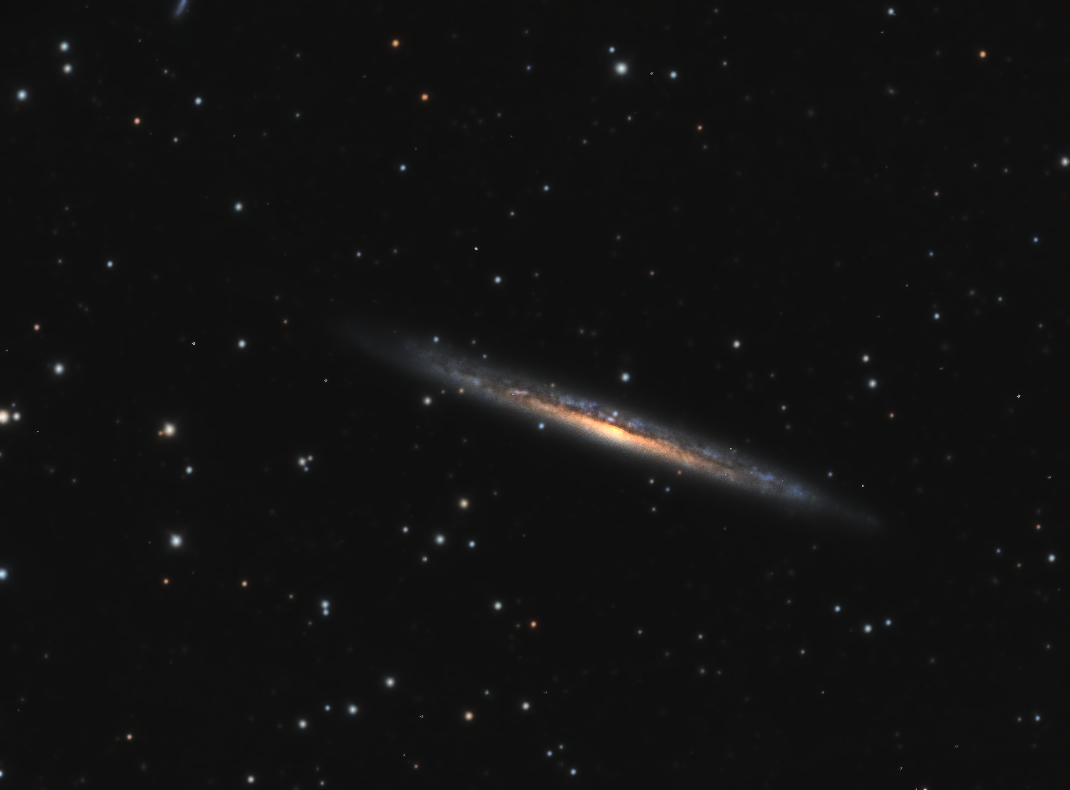
0
Hello Simon,
You sure don't make life easy for yourself do you. Was a new galaxy to me simply because I dismiss anything that isn't reasonably bright and a decent size. An excellent job on a difficult target, but now after having spent a couple of minutes looking it up, I now consider myself an expert.
I'm afraid I can only award you 9/10 on this one on the basis that you failed to capture any of the tidal stream. Told you I was now an expert on it. Shame really as I'm sure with a bit more effort, say a further 25 hours of exposure time, you could have captured a faint trace of it. That would definitely have earned a10/10, but quite probably got you kicked out of the house when the charge appeared on your next credit card statement!!!
Seriously thanks for sharing, now just wondering what next you'll have for us.
Hope you are able to get a decent amount of imaging time this weekend at home, despite the lack of truly dark skies here. Clear skies anyway...
Best regards,
Ray
You sure don't make life easy for yourself do you. Was a new galaxy to me simply because I dismiss anything that isn't reasonably bright and a decent size. An excellent job on a difficult target, but now after having spent a couple of minutes looking it up, I now consider myself an expert.
I'm afraid I can only award you 9/10 on this one on the basis that you failed to capture any of the tidal stream. Told you I was now an expert on it. Shame really as I'm sure with a bit more effort, say a further 25 hours of exposure time, you could have captured a faint trace of it. That would definitely have earned a10/10, but quite probably got you kicked out of the house when the charge appeared on your next credit card statement!!!
Seriously thanks for sharing, now just wondering what next you'll have for us.
Hope you are able to get a decent amount of imaging time this weekend at home, despite the lack of truly dark skies here. Clear skies anyway...
Best regards,
Ray
Ray
Roboscopes Guinea Pig
Phil,
I meant to say thanks for this! Somehow I missed out your kind comment. By the way, I was looking to process some stuff from Pier 11 but I do not think there are any calibration files for it - I think there are some other piers like this too. Should I wait for them to come through before I start anything please? Also how long will the data stay on the server, as I am very busy over the next few weeks and will have little time for processing anything. What should I do please?
Thanks again.
Simon
I meant to say thanks for this! Somehow I missed out your kind comment. By the way, I was looking to process some stuff from Pier 11 but I do not think there are any calibration files for it - I think there are some other piers like this too. Should I wait for them to come through before I start anything please? Also how long will the data stay on the server, as I am very busy over the next few weeks and will have little time for processing anything. What should I do please?
Thanks again.
Simon
Hi Simon,
I discovered your image after searching the forum for "Pier 8". This scope and new camera (recently upgraded, I gather?) has some desirable characteristics that I think I'll try out.
I understand that your image of NGC 5906 is LRGB, and in your own words you described post-processing as tricky. I performed an analysis and found that you have very high signal-to-noise ratio in your luminance stack but low SNR in your color stacks. This may very well be the reason why post-processing was difficult. I can see evidence of this when I magnify the galaxy's dust lane. The color channels are very noisy. Also, very faint stars farther from the galaxy are mere smudges of light. This can also be explained by low SNR in the color stacks.
May I ask if you tried creating a monochrome image from just the luminance frames?
Thanks,
Brian
I discovered your image after searching the forum for "Pier 8". This scope and new camera (recently upgraded, I gather?) has some desirable characteristics that I think I'll try out.
I understand that your image of NGC 5906 is LRGB, and in your own words you described post-processing as tricky. I performed an analysis and found that you have very high signal-to-noise ratio in your luminance stack but low SNR in your color stacks. This may very well be the reason why post-processing was difficult. I can see evidence of this when I magnify the galaxy's dust lane. The color channels are very noisy. Also, very faint stars farther from the galaxy are mere smudges of light. This can also be explained by low SNR in the color stacks.
May I ask if you tried creating a monochrome image from just the luminance frames?
Thanks,
Brian
Thank you Brian for your interest in this particular object. It is quite some time ago that I processed this and it was back in the earlier days... and you are correct the camera has been changed since then. The data I no longer have and it is no longer available, I think, and there were not too many subs. I am most impressed with your ability to analyse things and I think you are pretty much bang on with regard to the levels of snr compared together. I did not produce a monochrome luminance as suggested and I'm not quite sure what you mean by that, because in my simple understanding the luminance would be one anyway. But if you wish to share with me any thoughts around that, it may be helpful for a future object. All the best and thanks again! : ) Simon
Hi Simon,
I've attached two images that I took this past winter of the double cluster M35 and NGC 2158 in Gemini. I used my little 71mm f/5.9 achromat refractor and a 10-year old Atik 314E CCD. M35 consists mainly of bright blue stars and NGC 2158 of faint red stars. It took several nights to capture due to my east-only facing opportunity window and my intended objective of achieving a low noise image. I used Optolong LRGB filters.
I used AstroPixelProcessor (APP) for calibration, registration, stacking, color combine, and final stretch. As with most software the intermediate result is four stacks: one each for LRGB. At that point you can decide if you want to create a full color image or a monochrome image from just a single stack. If you want full color then you use APP's Color Combine tool but if you want a monochrome image of just the luminance channel then you just open the luminance stack file and stretch it.
The monochrome image that I attached is a stretch of my luminance stack. The color image is the result of combining the four stacks and then stretching it.
Notice that my monochrome image is not the same as a gray scaled version of my color image even though it may look that way. There is some extra work that APP performs in order to combine the stacks into color. Ideally you want the signal-to-noise ratio of each of the four stacks to be the same or approximately so. In the case of your NGC 5906 color image I calculated the following stack SNRs:
L: SNR 47
R: SNR 22
G: SNR 24
B: SNR 18
There are two problems:
1. The blue stack is significantly weaker than red and green but this can be corrected with your software's color calibration tools.
2. The biggest problem is that the color channels are much weaker than your luminance.
Regarding that second point, remember that luminance is there to give your color "brilliance". If you've got poor quality color then no amount of luminance can save it.
The root cause of the deficient color channels was the choice of exposure time. From your comments you mentioned 5-minute subs for RGB and 10-minute subs for L. As a general rule I would flip that around so as to take 10-minute RGB and 5-minute L since your color filters are letting in one-third the light of luminance. I take it a step further and set RGB exposure to be three times that of Luminance, so that would mean 15-minute RGB and 5-minute L. That way, in a single sub you've achieved SNR parity across all four channels. The final step is to follow the guidelines that RoboScopes gives with respect to color balance. For example, the KAF-16803 sensor requires you to capture 20% more red frames than green, and 33% more blue frames than green. (This is needed due to the sensor's QE curve.) After that you are now assured that the SNR of each of your four stacks is approximately equal. You will discover that post-processing will become a breeze.
Brian
PS: Please forgive my fat blue stars. If you buy a refractor, make sure it is an APO!
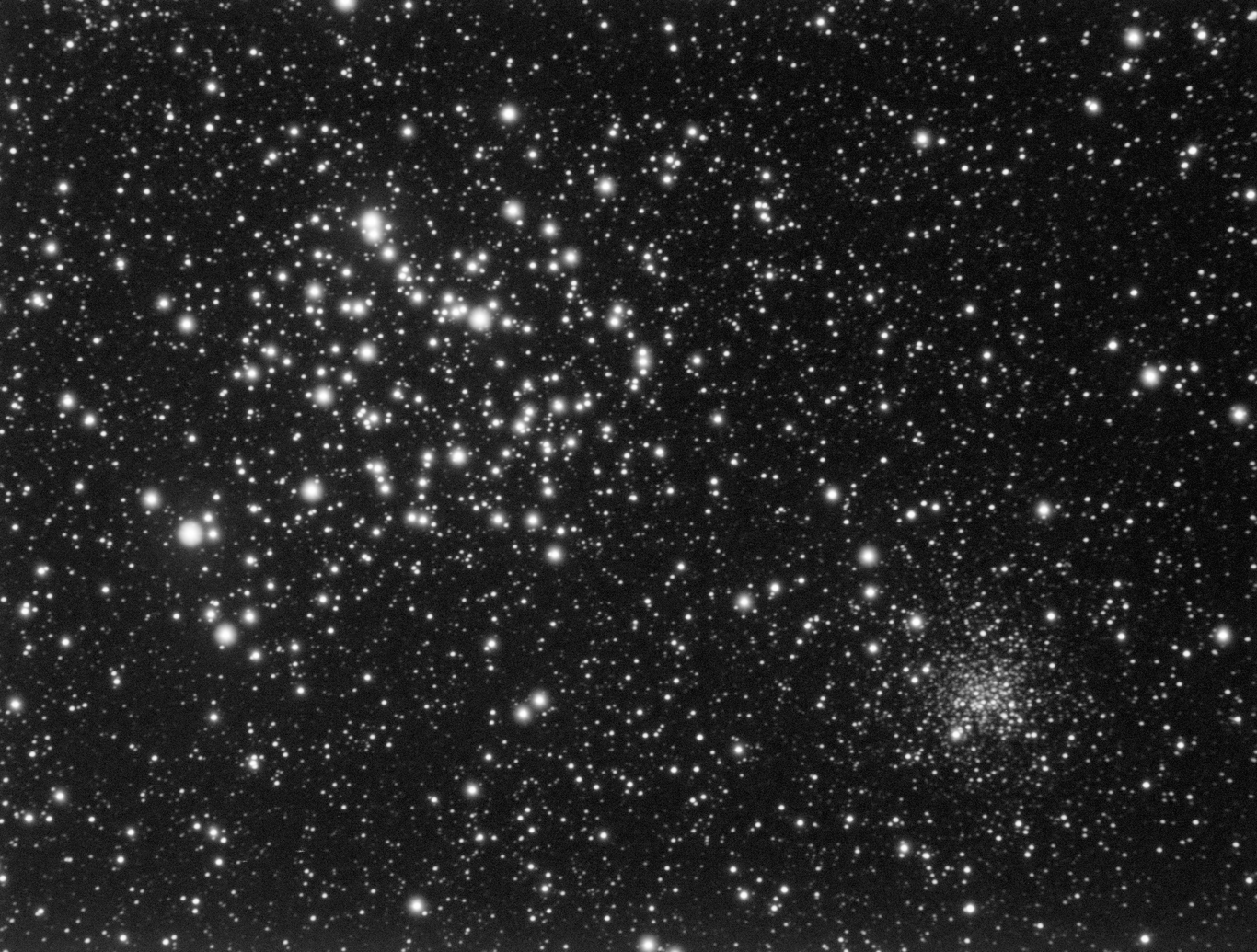
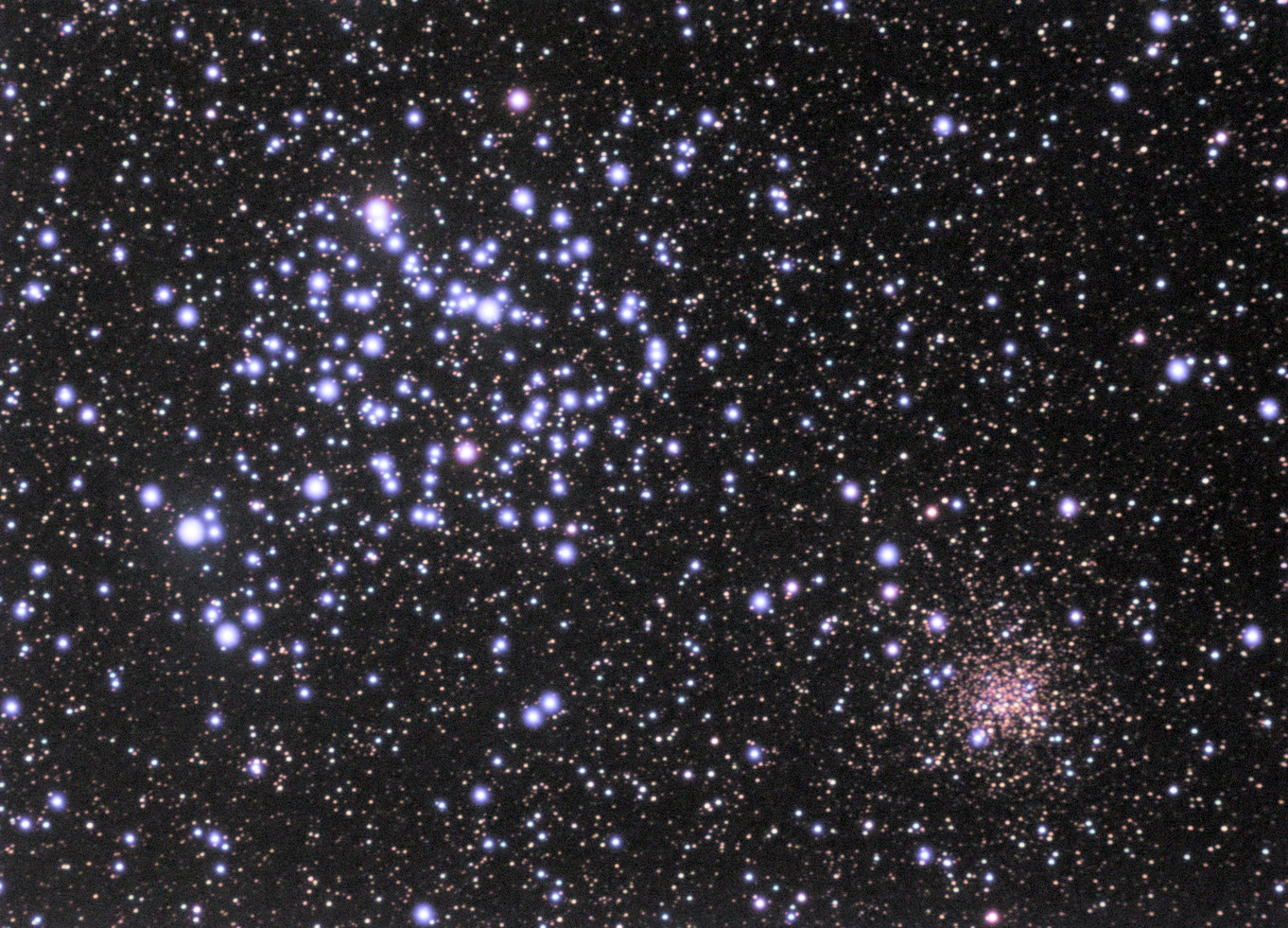
I've attached two images that I took this past winter of the double cluster M35 and NGC 2158 in Gemini. I used my little 71mm f/5.9 achromat refractor and a 10-year old Atik 314E CCD. M35 consists mainly of bright blue stars and NGC 2158 of faint red stars. It took several nights to capture due to my east-only facing opportunity window and my intended objective of achieving a low noise image. I used Optolong LRGB filters.
I used AstroPixelProcessor (APP) for calibration, registration, stacking, color combine, and final stretch. As with most software the intermediate result is four stacks: one each for LRGB. At that point you can decide if you want to create a full color image or a monochrome image from just a single stack. If you want full color then you use APP's Color Combine tool but if you want a monochrome image of just the luminance channel then you just open the luminance stack file and stretch it.
The monochrome image that I attached is a stretch of my luminance stack. The color image is the result of combining the four stacks and then stretching it.
Notice that my monochrome image is not the same as a gray scaled version of my color image even though it may look that way. There is some extra work that APP performs in order to combine the stacks into color. Ideally you want the signal-to-noise ratio of each of the four stacks to be the same or approximately so. In the case of your NGC 5906 color image I calculated the following stack SNRs:
L: SNR 47
R: SNR 22
G: SNR 24
B: SNR 18
There are two problems:
1. The blue stack is significantly weaker than red and green but this can be corrected with your software's color calibration tools.
2. The biggest problem is that the color channels are much weaker than your luminance.
Regarding that second point, remember that luminance is there to give your color "brilliance". If you've got poor quality color then no amount of luminance can save it.
The root cause of the deficient color channels was the choice of exposure time. From your comments you mentioned 5-minute subs for RGB and 10-minute subs for L. As a general rule I would flip that around so as to take 10-minute RGB and 5-minute L since your color filters are letting in one-third the light of luminance. I take it a step further and set RGB exposure to be three times that of Luminance, so that would mean 15-minute RGB and 5-minute L. That way, in a single sub you've achieved SNR parity across all four channels. The final step is to follow the guidelines that RoboScopes gives with respect to color balance. For example, the KAF-16803 sensor requires you to capture 20% more red frames than green, and 33% more blue frames than green. (This is needed due to the sensor's QE curve.) After that you are now assured that the SNR of each of your four stacks is approximately equal. You will discover that post-processing will become a breeze.
Brian
PS: Please forgive my fat blue stars. If you buy a refractor, make sure it is an APO!
Hi Simon,
Here are screenshots from a tool that I am working on that I want to make available to everyone who is doing LRGB Astrophotography.
One image is annotated "Original". This is an analysis based on the characteristics of the telescope, the new camera (since I don't have specs on the old camera you used), the object, and the exposure and frame counts you used.
The other image is annotated "Reworked". Everything is the same except I changed the exposures and frame counts in order to achieve balanced SNR across all four channels as highlighted.
Brian
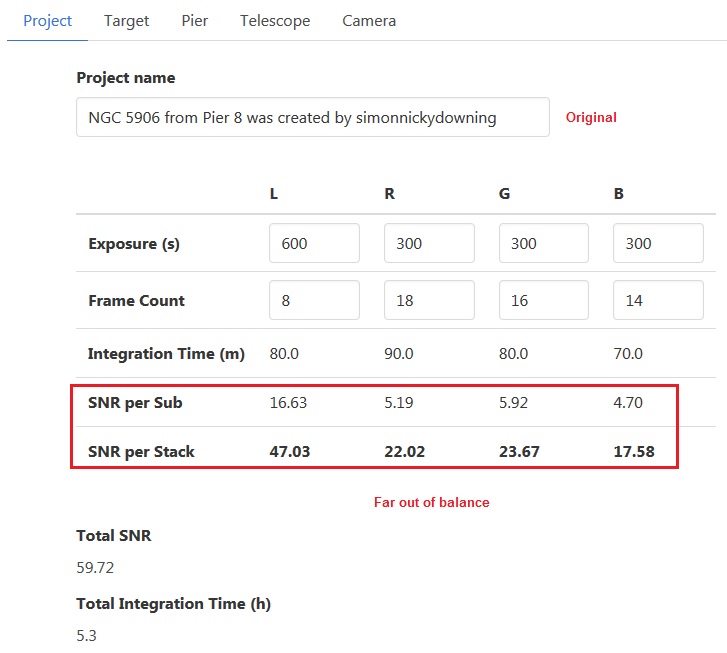
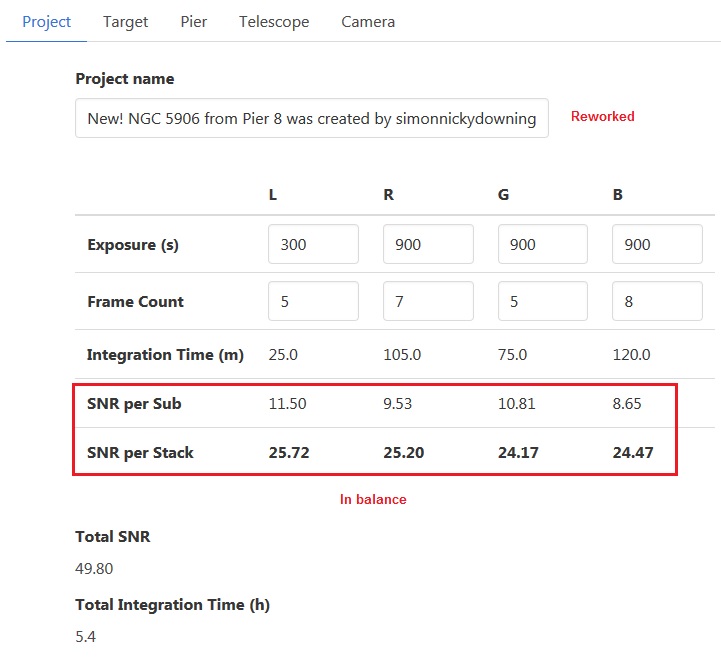
Here are screenshots from a tool that I am working on that I want to make available to everyone who is doing LRGB Astrophotography.
One image is annotated "Original". This is an analysis based on the characteristics of the telescope, the new camera (since I don't have specs on the old camera you used), the object, and the exposure and frame counts you used.
The other image is annotated "Reworked". Everything is the same except I changed the exposures and frame counts in order to achieve balanced SNR across all four channels as highlighted.
Brian
Simon,
One final thought. Like you, I'd like to capture the "stellar streams". My guess, and this is just off the top of my head, you might want to shoot for Total SNR of 100 or more.
I just ran the numbers. We are looking at Total Integration Time of 22 hours to achieve Total SNR of 100.
That is a significant investment! Perhaps we can make this a group project so as to share the cost.
Brian
One final thought. Like you, I'd like to capture the "stellar streams". My guess, and this is just off the top of my head, you might want to shoot for Total SNR of 100 or more.
I just ran the numbers. We are looking at Total Integration Time of 22 hours to achieve Total SNR of 100.
That is a significant investment! Perhaps we can make this a group project so as to share the cost.
Brian
Simon,
SNR 100 is just a guess. Since this is a multi-session project I would approach it by first capturing Luminance. Capture as much as it takes to see hints of the stellar stream. Only then would I recommend capturing RGB based on calculations but it may be prohibitively costly to proceed.
Brian
SNR 100 is just a guess. Since this is a multi-session project I would approach it by first capturing Luminance. Capture as much as it takes to see hints of the stellar stream. Only then would I recommend capturing RGB based on calculations but it may be prohibitively costly to proceed.
Brian
Brian,
Many thanks for all your investigative work, and to be honest the data I used was something I received and thus it was pre-selected with the exposure lengths and numbers of subs. At the time I thought that it needed longer RGB exposure times and numbers of subs too, and I think you are correct, the cost of really going as far as we would like with this object would be prohibitive. However, what you have done is get me thinking about my own selectivity from the options for LRGB in the future as parity is vital, and in terms of the monochrome luminance, I think I was already doing that, although through Pixinsight, which is the only programme I use, and just about understand! I really like your M35 and your new and clever tool - so useful I feel for many! Fortunately I have an Apo which I use here on the south coast, along with my 8" reflector, if the skies clear. Anyway, keep in touch...
Thanks again.
Simon : )
Many thanks for all your investigative work, and to be honest the data I used was something I received and thus it was pre-selected with the exposure lengths and numbers of subs. At the time I thought that it needed longer RGB exposure times and numbers of subs too, and I think you are correct, the cost of really going as far as we would like with this object would be prohibitive. However, what you have done is get me thinking about my own selectivity from the options for LRGB in the future as parity is vital, and in terms of the monochrome luminance, I think I was already doing that, although through Pixinsight, which is the only programme I use, and just about understand! I really like your M35 and your new and clever tool - so useful I feel for many! Fortunately I have an Apo which I use here on the south coast, along with my 8" reflector, if the skies clear. Anyway, keep in touch...
Thanks again.
Simon : )
Brian,
Many thanks for all your investigative work, and to be honest the data I used was something I received and thus it was pre-selected with the exposure lengths and numbers of subs. At the time I thought that it needed longer RGB exposure times and numbers of subs too, and I think you are correct, the cost of really going as far as we would like with this object would be prohibitive. However, what you have done is get me thinking about my own selectivity from the options for LRGB in the future as parity is vital, and in terms of the monochrome luminance, I think I was already doing that, although through Pixinsight, which is the only programme I use, and just about understand! I really like your M35 and your new and clever tool - so useful I feel for many! Fortunately I have an Apo which I use here on the south coast, along with my 8" reflector, if the skies clear. Anyway, keep in touch...
Thanks again.
Simon : )
Many thanks for all your investigative work, and to be honest the data I used was something I received and thus it was pre-selected with the exposure lengths and numbers of subs. At the time I thought that it needed longer RGB exposure times and numbers of subs too, and I think you are correct, the cost of really going as far as we would like with this object would be prohibitive. However, what you have done is get me thinking about my own selectivity from the options for LRGB in the future as parity is vital, and in terms of the monochrome luminance, I think I was already doing that, although through Pixinsight, which is the only programme I use, and just about understand! I really like your M35 and your new and clever tool - so useful I feel for many! Fortunately I have an Apo which I use here on the south coast, along with my 8" reflector, if the skies clear. Anyway, keep in touch...
Thanks again.
Simon : )
Hi Simon,
Gosh, some really interesting stuff on this thread since I last visited.
Anyway, thank goodness Simon we have a guru on our forum now. It would have probably cost you your marriage and everything else if you had heeded my suggestion of an additional 25 hours of imaging, when it seems likely from what Brian brilliantly explained, you would need significantly less! Honestly I'm not on any commission from roboscopes to drum up business! Honest.
Honest.
Cheers
Ray
Gosh, some really interesting stuff on this thread since I last visited.
Anyway, thank goodness Simon we have a guru on our forum now. It would have probably cost you your marriage and everything else if you had heeded my suggestion of an additional 25 hours of imaging, when it seems likely from what Brian brilliantly explained, you would need significantly less! Honestly I'm not on any commission from roboscopes to drum up business!
Cheers
Ray
Ray
Roboscopes Guinea Pig
Ray,
Thanks but I'm not a guru. I'm just a programmer with an interest in math. I'm fortunate to have a friend in England who shares my interest in taking a scientific approach to imaging. We both suffer from interminable cloudy skies so we've collaborated. There are so many levers to pull and each has its affect on the image. If we were given endless nights of clear skies I think we would be happy to experiment but given the reality of the situation we've had to throw math at the problem.
I searched AstroBin for NGC 5906 and discovered two pages of images. Only one captured the tidal stream. Not surprisingly he won Image of The Day accolades. Total Integration Time: 27.5 hours using a 16-inch Richie-Chretien at f/9 at a remote site. 30-minute exposures LRGB most of which is luminance. I see he used PixInsight so it appears there are ways to mix-in very little RGB into a mostly L image. When I try that with APP I don't get the same results. So it does look like there are ways but one must be an absolute expert at the software. The good thing about balancing SNR across all channels is that you get a rich colorful image that is a breeze to process.
https://www.astrobin.com/254701/B/
Brian
Thanks but I'm not a guru. I'm just a programmer with an interest in math. I'm fortunate to have a friend in England who shares my interest in taking a scientific approach to imaging. We both suffer from interminable cloudy skies so we've collaborated. There are so many levers to pull and each has its affect on the image. If we were given endless nights of clear skies I think we would be happy to experiment but given the reality of the situation we've had to throw math at the problem.
I searched AstroBin for NGC 5906 and discovered two pages of images. Only one captured the tidal stream. Not surprisingly he won Image of The Day accolades. Total Integration Time: 27.5 hours using a 16-inch Richie-Chretien at f/9 at a remote site. 30-minute exposures LRGB most of which is luminance. I see he used PixInsight so it appears there are ways to mix-in very little RGB into a mostly L image. When I try that with APP I don't get the same results. So it does look like there are ways but one must be an absolute expert at the software. The good thing about balancing SNR across all channels is that you get a rich colorful image that is a breeze to process.
https://www.astrobin.com/254701/B/
Brian
Hi Brian,
Just caught this reply before signing out. You are very modest.
Thanks for the link to the image on Astrobin. Considering the expense involved to capture that tiny extra bit of light I was considering making a suggestion involving Photoshop. Luckily I caught myself in time. It would probably have been classed in the same league as blasphemy in astrophotography circles, and got me booted off the forum.
Cheers,
Ray
Just caught this reply before signing out. You are very modest.
Thanks for the link to the image on Astrobin. Considering the expense involved to capture that tiny extra bit of light I was considering making a suggestion involving Photoshop. Luckily I caught myself in time. It would probably have been classed in the same league as blasphemy in astrophotography circles, and got me booted off the forum.
Cheers,
Ray
Ray
Roboscopes Guinea Pig
- Page :
- 1
There are no replies made for this post yet.
Be one of the first to reply to this post!
Be one of the first to reply to this post!
This website uses cookies to manage authentication, navigation, and other functions. By using our website, you agree that we can place these types of cookies on your device.
You have declined cookies. This decision can be reversed.
Proud to use
-
FLI
-
656 Imaging
-
10 Micron
-
Planewave
-
ZWO
Resources
Company Details:
Roboscopes
802 Kingsbury Road
Birmingham
B24 9PS
United Kingdom





